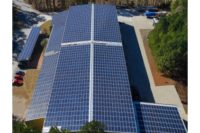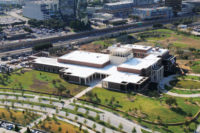Taking the Heat: Solar Panels and Cool Roofs

The National Computer Center makes use of a cool roof and solar panel combination.

The center’s photovoltaic system output has increased since a white roof was installed.

Images courtesy of the U.S. EPA.


Residential, as well as commercial, roofs can benefit from a solar and cool roof integration. Image courtesy of Coat’N’Cool.





Solar panels and cool roofs are a natural integration of sustainable technologies that can increase the output of a photovoltaic system by as much as 10 percent. Whether you are a developer of commercial/industrial properties or a multifamily builder thinking about installing a solar power system to reduce energy costs, you should seriously consider a cool roof as part of the installation package.
One solar installation company that has embraced the merger is Advanced Powering Services Inc., of Rancho Santa Margarita, Calif., which has installed a cool roof/solar panel beta test site on the roof of a local industrial building. According to the beta test, a cool roof reduced the ambient temperature of the roof covering by 10 degrees, and in so doing increased the generating performance of the PV panels by 11.5 percent to 13.2 percent. The system is projected to save the building owner $1,235 annually in energy costs.
OPTIMAL TEMPERATURE IMPROVES PERFORMANCE
“We attribute this increased performance to the fact that the cool roof maintains a lower, more optimal roof temperature, which benefits the performance of the solar panels,” explains Tim Scharf, Advanced Powering’s chief operating officer. Scharf points out that solar systems work best at temperatures below 90 degrees, and that if temperatures exceed 110 degrees, the solar power output can be reduced by as much as 50 percent.
- The beta test also shows that a cool roof coating has other benefits:
- It increased the insulating value of the roof from R-17 to R-31.
- 21 percent less energy was consumed for air conditioning.
- Non-air conditioned space under a cool roof was 14 degrees cooler than space under a traditional dark roof.
- A cool roof requires less maintenance than a traditional dark roof and has a longer life if properly maintained.
Based on Coat’N’Cool’s experience, a reflective roof coating can lower interior temperatures of a commercial or industrial building by 8 to 12 degrees during the hottest four hours of a summer day, noon to four in the afternoon. Not only does the lower interior temperature help reduce energy costs, it also improves worker productivity, especially in a non-air conditioned space, by creating a working environment that is simply more comfortable.
Bill Conley, CFM, CFMJ, LEED AP, an Aliso Viejo, Calif.-based facility management and sustainability consultant and board member of International Facilities Management Association, is a proponent of combining cool roofs with solar. He points out that as a facilities manager his goal is to achieve the best possible operating configuration that saves money and energy, optimizes sustainability and ensures the longest possible usage of a building and its components.
According to Conley, who is a long-time advocate of sustainability, a cool roof combined with solar can improve the performance, and thus economics, of a PV system and at the same time be an important operating benefit for commercial property owners. Cool roof installations in California are being promoted by the support of the U.S. Department of Energy’s ENERGY STAR Program and by the requirements of the California’s Title 24 CalGreen energy standard, which prescribes cool roofs to be employed whenever low-slope commercial roofs are constructed or replaced.
Echoing Conley, Ian McLaughlin with Lineside Electric, a San Juan Capistrano-based installer of solar systems, states, “A cool roof as an integral component of a solar installation enhances reflectivity and other benefits such as cooling a building’s interior that can significantly improve the operation and efficiency of the photovoltaic system.”
The condition of the roof is also important. “If you are considering a new roof, you should seriously consider installing a cool roof and, if possible, a solar system on that roof all at the same time,” explains David Montross, president of Montross Roofing, an Orange County, Calif.-based firm that specializes in roofing, decking and construction services.
“A cool roof reduces building cooling requirements by lowering the temperature of the roof and the building underneath,” he notes. “This means cooling equipment savings and, in many cases, the ability to run less air conditioning or purchase smaller air conditioning units. A cool roof will also increase the life of a roof. By lowering the roof temperature, roofing products may last longer due to less thermal stress over time.”
THE EPA NATIONAL COMPUTER CENTER
One of the more prominent buildings that combines a cool roof with solar panels is the Environmental Protection Agency’s 101,000-square-foot National Computer Center in the Research Triangle of North Carolina. The computer center, which achieved a LEED-NC Silver rating in early 2005, handles a massive quantity of data processing equipment. To achieve the Silver rating and reduce the building’s substantial power load, 15,000 square feet of the roof is covered with solar panels on top of a white, highly reflective, ENERGY STAR-compliant, cool roof membrane (reinforced thermoplastic polyolefin) that reduces unwanted heat during the cooling season.
The solar power system consists of a 94-kW (peak) photovoltaic array made up of 2,185 individual tiles. Each tile is a stacked composite made up of a layer of rigid polystyrene foam insulation board, a wiring chase and airspace, and a PV module. Each tile interlocks with adjacent tiles and rests on top of the membrane-covered roof deck with no mechanical penetrations. The output of the PV array offsets approximately 5 percent of the building’s electricity consumption, which is estimated to be approximately twice that of a conventional office building of equivalent size due to the large demand from data-processing equipment.
Greg Eades, energy manager for the EPA Research Triangle Park campus, says that while he has no specific data on the effect that the cool roof has on the performance of the PV system, it does appear that the roof is beneficial. Specifically, he points out that the power output of the system has increased over the past three years from 85,000 kWh to 105,000 kWh while the “insolation” factor has decreased (insolation is a measure of solar radiation energy received on a given surface area in a given time).
“One would expect that if the solar output is increasing, that the insolation is also increasing,” Eades explains. “However, for this system, the opposite is happening. The energy has increased while the insolation has decreased, which is counterintuitive. Although we don’t have the data to prove it, one could surmise that the reason for the inverse relationship is the presence of the cool roof. If that is the case, then the cool roof is definitely beneficial.”
THE IMPORTANCE OF A COOL ROOF
Cool roofing systems can significantly reduce roof temperatures during the summer, which by itself improves the performance of a photovoltaic system. Another benefit of a cool roof as underscored by the Advanced Powering Services beta test is that it can significantly enhance the performance of solar panels by lowering a building’s interior temperature, thus reducing the power load necessary for air conditioning during hot summer days. This has many benefits including cutting energy costs by keeping attics and ducts cooler, improving occupant comfort, cutting maintenance costs, increasing the life cycle of the roof, and reducing urban heat islands along with associated smog. It’s a win-win situation from every viewpoint.
Solar reflectance and thermal emittance are the two measures used to determine the “coolness” of a roof. Solar Reflectance Index (SRI) of a roofing product is a method for determining the radiative properties of roofing materials. SRI is defined by ASTM Standard E1980-01; the EPA summarizes SRI as “the relative steady-state surface temperature with respect to the standard white (SRI=100) and standard black (SRI=0) under the standard solar and ambient conditions.”
White reflective coatings contain transparent polymeric materials, such as acrylic, and a white pigment, such as titantium dioxide (rutile), to make them opaque and reflective. These coatings typically reflect 70 to 80 percent of the sun’s energy. Despite the white appearance, these pigments absorb the 5 percent or so of the sun’s energy that falls in the ultraviolet spectrum. Thus, the pigments help protect the polymer material and the substrate underneath from UV damage. As long as the coating is white or light-colored, the roof will have high reflectance and emittance levels.
Researchers at Concordia University report in a new cool roof study that even a slight improvement in the reflectivity of roof and hardscape surfaces could lead to a global reduction of billions of tons of carbon dioxide, a key ingredient in global warming. An increase as small as 1 percent in the amount of white roofs or roads installed across the urban world would reduce the volume of carbon dioxide released into the atmosphere by upward of 130 billion tons over the next 50 to 100 years, the study states.
Looking for a reprint of this article?
From high-res PDFs to custom plaques, order your copy today!










